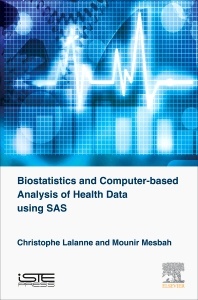Description
Biostatistics and Computer-based Analysis of Health Data Using SAS
Language: English
Subjects for Biostatistics and Computer-based Analysis of Health Data...:
Support: Print on demand
Description
/li>Contents
/li>Readership
/li>Biography
/li>Comment
/li>
This volume of the Biostatistics and Health Sciences Set focuses on statistics applied to clinical research. The use of SAS for data management and statistical modeling is illustrated using various examples. Many aspects of data processing and statistical analysis of cross-sectional and experimental medical data are covered, including regression models commonly found in medical statistics.
This practical book is primarily intended for health researchers with a basic knowledge of statistical methodology. Assuming basic concepts, the authors focus on the practice of biostatistical methods essential to clinical research, epidemiology and analysis of biomedical data (including comparison of two groups, analysis of categorical data, ANOVA, linear and logistic regression, and survival analysis). The use of examples from clinical trials and epidemiological studies provide the basis for a series of practical exercises, which provide instruction and familiarize the reader with essential SAS commands.
1. Language Elements 2. Simple Descriptive Statistics 3. Measures of Association, Comparison of Means or Proportions 4. Correlation, Linear Regresion 5. Logistic Regression 6. Survival Curves, Cox Regression
Mounir Mesbah is Head of Biostatistics in the Statistics Institute of the Pierre and Marie Curie University in Paris, France, where he is also a researcher at the Theoretical and Applied Statistics Laboratory. His research involves theoretical and applied statistics, particularly in the field of health and medicine.
- Presents the use of SAS software in the statistical approach for the management of data modeling
- Includes elements of the language and descriptive statistics
- Supplies measures of association, comparison of means, and proportions for two or more samples
- Explores linear and logistic regression
- Provides survival data analysis




